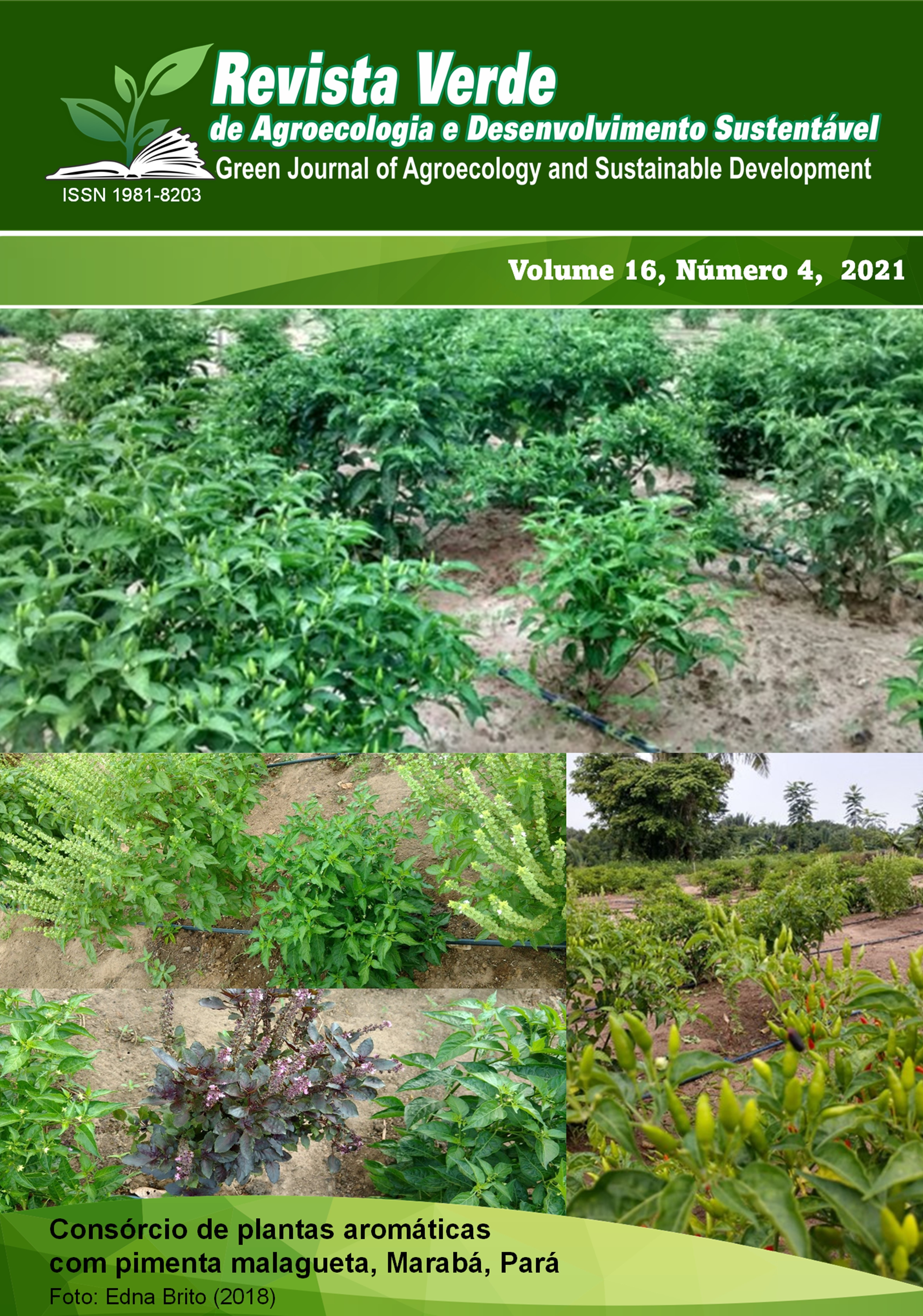Diversity of natural enemies in cotton cultivated in different spaces
DOI:
https://doi.org/10.18378/rvads.v16i4.8563Keywords:
Natural enemies, Narrow, Biological control, Fauna analysisAbstract
Accurate estimates of the abundance and diversity of natural enemies are of important for the development of pest management techniques. With this knowledge, it is possible to optimize control practices when populations reaches the economic threshold level, with focus upon the adoption of more sustainable practices, such as those that advocate conservative biological control. In view of this, the present research sought to characterize the fauna diversity of natural enemies of the cotton aphid grown in different spacing. The research was conducted in an experimental field at Embrapa Cotton. The following spacings were adopted: 0.40 m x 0.20 m (E1), 0.80 m x 0.20 m (E2) and 1.60 m x 0.20 m (E3). Fauna analysis revealed that there is a difference in the pattern of occurrence of natural enemies Chrysoperla externa (Hagen, 1861) (Neuroptera, Chrysopidae), Cycloneda sanguinea (Linnnaeus, 1763) (Coleoptera: Coccinelidae), Scymnus sp. (Coleoptera, Coccinelidae), Toxomerus sp. (Diptera: Syrphidae) and Orius insidiosus (Say) (Heteroptera, Anthocoridae) as a function of the spacing (between lines) adopted. In general, the most abundant species was Lysiphlebus testaceipes (Cresson) (Hymenoptera: Aphidiidae). On the other hand, there is no evidence of difference between the spacing for Shannon's diversity indexes, the Pielou Equability index and the Simpson index. Therefore, the results of the present study reinforce the hypothesis that the individual frequency of the species of natural enemies raised varies according to the cotton planting configuration, an exception is given to parasitoid L. testaceips. On the other hand, there are no differences between the spacing adopted in relation to the diversity of natural enemies.
Downloads
References
BROWER, J. E.; ZARR, J. H. Field & laboratory methods for general ecology. 2 ed. Wm. C. Brown Publishers, Dubuque, Iowa, 226p. 1984.
BANDEIRA, C. M.; WANDERLEY, P. A.; RAMALHO, F. S.; SILVA, G. F.; SILVA, J. P. S.; MALAQUIAS, J. B.; PEREIRA, A. I. A.; ZANUNCIO, J. C. Spatial models of distribution of Lisiphlebus testaceips (Cresson)(Hymenoptera: Braconidae) a parasitic wasp of Aphis gossipii Glover on cotton. In: XXI Congresso de Entomologia, 2006.
CLEGG, M. D., Francis, C. A. Crop management. p. 135–156. In J.L. Hatfield and D.L. Karlen (ed.) Sustainable agricultural systems. CRC Press, Boca Raton, FL. 1994.
FERREIRA, A. C. D. B.; BORIN, A. L. D. C.; BRITO, G. G. D.; SILVA FILHO, J. L. D.; BOGIANI, J. C. Épocas de semeadura, cultivares e densidades de plantas para algodão adensado em segunda safra. Pesquisa Agropecuária Tropical, 45(4), 397-405, 2015.
GRAVENA, S.; STERLING, W. L. Natural predation on the cotton leafworm (Lepidoptera: Noctuidae). Journal of Economic Entomology, 76(4): 779, 1983.
HOGENHOUT, S. A.; AMMAR, E.D.; WHITFIELD, A. E.; REDINBAUGH, M. G. Insect Vector Interactions with Persistently Transmitted Viruses. Annual Review of Phytopathology 46: 327–359, 2008. https://doi.org/10.1146/annurev.phyto.022508.092135
IAMAMOTO, M. M. Doenças foliares do algodoeiro. Jabuticabal: Funesp 45p. 2005.
MACEDO, L. P. M.; MOURA FILHO, E. R.; CARVALHO, A. S.; BEZERRA, C. E. S.; SILVEIRA, L. C. P. Occurrence of Lysiphlebus testaceipes parasitizing Aphis gossypii in watermelon in the State of Rio Grande do Norte, Brazil. Ciência Rural, 40(9): 2030-2032, set, 2010.
LIMA, T. A.; MALAQUIAS, J. B.; PACHU, J. K. S.; RAMALHO, F. S.; ISIDRO, R.; LIRA, A. C. S. Distribuição espacial de Lysiphlebus testaceipes (Cresson) (Hymenoptera: Aphidiidae) em algodoeiro cultivado em sistema adensado. v.49, n.1, p.14–18, 2021. http://dx.doi.org/10.15361/1984-5529.2021v49n1p14-18
MALAQUIAS, J. B.; RAMALHO, F. S.; DIAS, C. T. D. S.; BRUGGER, B. P.; LIRA, A. C. S.; WILCKEN, C. F., PACHU, J. K. S.; ZANUNCIO, J. C. Multivariate approach to quantitative analysis of Aphis gossypii Glover (Hemiptera: Aphididae) and their natural enemy populations at different cotton spacings. Scientific Reports, 7: 41740, 2017a. https://doi.org/10.1038/srep41740
MALAQUIAS, J. B.; GODOY, W. A.; GARCIA, A. G.; RAMALHO, F. D. S.; OMOTO, C. Larval dispersal of Spodoptera frugiperda strains on bt cotton: a model for understanding resistance evolution and consequences for its management. Scientific reports, 7(1), 1-10, 2017b. https://doi.org/10.1038/s41598-017-16094-x
MALAQUIAS, J. B.; CAPRIO, M. A.; GODOY, W. A.; OMOTO, C.; RAMALHO, F. S.; PACHÚ, J. K. Experimental and theoretical landscape influences on Spodoptera frugiperda movement and resistance evolution in contaminated refuge areas of Bt cotton. Journal of Pest Science, 93(1): 329-340, 2020. https://doi.org/10.1007/s10340-019-01145-1
MHLANGAA, B.; MUONI, T.; MASHAVAKURE, N.; MUDADIRWA, D.; MULENGA, R.; SITALI, M.; THIERFELDER, C.Friends or foes? Population dynamics of beneficial and detrimental aerial arthropods under Conservation Agriculture. Biological Control. Volume 148, 2020. https://doi.org/10.1016/j.biocontrol.2020.104312
PACHÚ, J. K.; MACEDO, F. C.; DA SILVA, F. B.; MALAQUIAS, J. B.; RAMALHO, F. S.; OLIVEIRA, R. F.; GODOY, W. A. Imidacloprid-mediated stress on non-Bt and Bt cotton, aphid and ladybug interaction: Approaches based on insect behaviour, fluorescence, dark respiration and plant electrophysiology. Chemosphere, 263: 127561. 2020. https://doi.org/10.1016/j.chemosphere.2020.127561
ROMANO, D.; PAPA, G. Ocorrência de lepidópteros-praga na cultura do algodoeiro transgênico (bt) e convencional cultivado no sistema adensado e não-adensado com e sem aplicação de inseticidas. Cultura Agronômica: Revista de Ciências Agronômicas, 24(4): 281-292, 2015.
SOUTHWOOD, T. R. E. Ecological methods: with particular reference to the study of insect populations. 2.ed. London: Chapman & Hall, 1995. 524p.
WALLNER, W. E. Factors affecting insect population dynamics: differences between outbreak and non-outbreak species Annu. Rev. Entomol., 32: 317-340, 2003.















